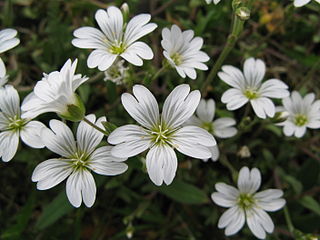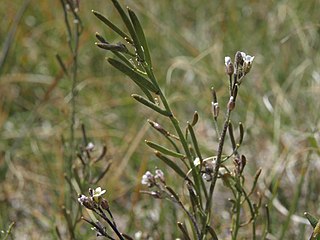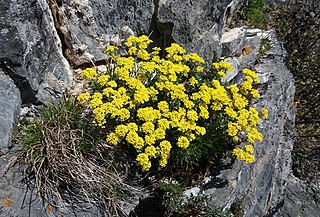Related Research Articles

Matthiola is a genus of flowering plant in the mustard family Brassicaceae. It is named after Italian naturalist Pietro Andrea Mattioli (1501–1577). The genus contains about 50 species of annual, biennial and perennial herbaceous plants and subshrubs. Many are cultivated for their heavily scented, colorful flowers.

Cardamine is a large genus of flowering plants in the mustard family, Brassicaceae, known as bittercresses and toothworts. It contains more than 200 species of annuals and perennials. Species in this genus can be found in diverse habitats worldwide, except the Antarctic. The name Cardamine is derived from the Greek kardaminē, water cress, from kardamon, pepper grass.
There are over 190 vascular plant species on the Norwegian Arctic archipelago of Svalbard. This figure does not include algae, mosses, and lichens, which are non-vascular plants. For an island so far north, this number of species constitutes an astonishing variety of plant life. Because of the harsh climate and the short growing season, all the plants are slow growing. They seldom grow higher than 10 cm (4 in)

Isatis is a genus of flowering plants in the family Brassicaceae, native to the Mediterranean region east to central Asia. Its genus name, Isatis, derives from the ancient Greek word for the plant, ἰσάτις. The genus includes woad. Due to their extremely variable morphology, the Asian species in particular are difficult to determine; the only reliable diagnostic feature is the ripe fruit. They are (usually) biennial or perennial herbaceous plants, often bluish and hairless or downy hairy with the upright stem branched.

Cerastium is a genus of annual, winter annual, or perennial flowering plants belonging to the family Caryophyllaceae. They are commonly called mouse-ears or mouse-ear chickweeds. There are 214 accepted species, found nearly worldwide but with the greatest concentration in the northern temperate regions. A number of the species are common weeds in fields and on disturbed ground.

Draba is a large genus of flowering plants in the family Brassicaceae, commonly known as whitlow-grasses.

Sisymbrium is a genus of plants in the family Brassicaceae.

Turritis is a plant genus in the family Brassicaceae. It contains the following two species:

Eutrema is a genus of flowering plants of the family Brassicaceae, native to the Holarctic. Its best known member is wasabi, Eutrema japonicum. The name comes from the Greek εὐ- (eu-) 'well' et τρῆμα (trêma) 'hole', because of a hole in the septum of the fruit.
Weberbauera is a genus of flowering plants in the crucifer family Brassicaceae, native to the central Andes; Peru, Chile, Bolivia, and Argentina.

Noccaea is a problematic genus of flowering plants in the family Brassicaceae, native to temperate areas of western North America, southern South America, northern Africa, Europe and Asia.

Crucihimalaya is a genus of flowering plants belonging to the family Brassicaceae.

Odontarrhena is a large genus of flowering plants in the family Brassicaceae. They were originally a separate genus and then were amalgamated into the Alyssum genus, but then morphological and molecular evidence has reseperated them. Some of the genera are nickel (Ni) hyperaccumulators.
References
- ↑ Brassicaceae Burnett. Plants of the World Online . Retrieved 2 April 2024.
- ↑ Francis, Ardath; Lujan-Toro, Beatriz E.; Warwick, Suzanne; Macklin, James A.; Martin, Sara L. (2021). "Update on the Brassicaceae Species Checklist". Biodiversity Data Journal. 9: e58773. doi: 10.3897/BDJ.9.e58773 . PMC 7952366 . PMID 33716543. The dataset is also available at https://data.catalogueoflife.org/dataset/2305/about ( doi : 10.48580/d4tm-4rj).
- ↑ Koch, Marcus A.; Kiefer, Markus; German, Dmitry; Al-Shehbaz, Ihsan A. "BrassiBase" . Retrieved 31 December 2021.